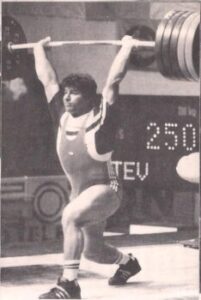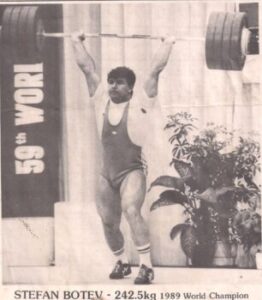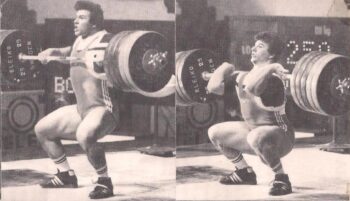One of my favorite weightlifters to watch was Stefan Botev. Botev was born on Feb.14, 1968, in Harmanli, Bulgaria, and was coached by the legendary Ivan Abadzhiev.
Stefan stood 5′ 11 (180 centimeters) and competed in the 110 kilo/242 lbs weight class. Later in his career, he moved up to the Superheavyweight class but was light for that class, usually weighing no more than 120 kilos/264 lbs.
His list of achievements is quite impressive. In 1987, at nineteen, he broke the World Record in the clean and jerk, lifting 250 kilos/551 pounds, and won a silver medal at the European Championships. He won the silver medal again at the 1988 European.

In 1989, he won the gold medal in the 110-kilo class at the World Championships, defeating the 1988 Olympic champion, Yury Zakharevich. In 1990, he again won the gold at the World Championships, defeating the silver medalist by an astounding 50 kilos/110 lbs.

Botev at the Olympics
Botev won a bronze medal at the 1992 Summer Olympic Games for Bulgaria. No longer under communist rule and now a citizen of Australia, Botev won a silver medal at the 1993 World Championships in the new 108-kilo weight class.
In 1994 and 1995, Botev moved to the super heavyweight class and won a bronze medal in the World Championships, quite an achievement, considering he was competing against lifters who outweighed him by a substantial amount.
In 1996, Botev won a bronze medal at the Summer Olympics, again competing against athletes who were much bigger than he was.
You can find numerous videos of Stefan Botev on YouTube, but my personal favorite is from Randall Strossen (IronMind Videos). This video shows Botev in the training hall preparing for the 1995 World Championships in China.
If you’re an Olympic weightlifter or even just someone who lifts weights to stay in shape, I highly recommend watching this video. Notice Stefan’s deadly, serious attitude, which is one reason why I enjoy watching him train. I practice this attitude myself and demand it from anyone I train with or coach. No cell phones, music, tomfoolery, or talking unless it pertains to lifting. Lifting heavy weights is serious business! I believe in 100% focus.
Stefan is 28 years old in this video and is now a citizen of Australia. However, his training regimen is similar to how he trained while lifting for Bulgaria. While no longer training six times a day as was the norm under the coaching of Abadzhiev, the volume and intensity of his training remained very high. There was nothing complicated about these workouts. They trained hard and heavy, focusing on the Olympic lifts and squats.
Warning alert: Before you consider training this way, remember that these are world-class athletes, the best at what they do, and if we are going to be completely honest, it’s not a big secret that they use PEDs. But if you think all it takes is PEDs to lift these kinds of weights, you are sadly mistaken.
For these guys, heavy training every day is commonplace. At the beginning of this video, the commentator mentions that Botev snatched 190/419 yesterday and snatched it again today. He also snatched 180/396 for a double. As if that wasn’t enough, he did clean and jerks and finished the workout with squats, three sets of four, with 280/617.
The commentator will also mention that Botev took minimal rest between sets, sometimes less than a minute. That is amazing for someone weighing 120/264. He was in tremendous condition!
After snatching 190 two days in a row, Stefan does an easy 240/529 C&J and follows that with cleans, 215 x 2, 220 x 2, and a 200 C&J—all in a day’s work. The commentator said he proceeded with a front squat workout that morning, 260/573 for doubles. Amazing stamina!
Next, take note of the squat stands, or lack thereof. Botev and his training partner figure out a way to make it work. Botev goes up to 290/639 for a double and then does 270/595 for five to get a little extra volume in.
Note that Botev does not use a belt, knee wraps, wrist wraps, or spotters. Why not have his training partner spot him from behind, you ask? Just think about how extremely dangerous that is. They are already being forced to make do with makeshift squat stands.
What happens if Botev gets stuck at the bottom and can’t come out of the squat? Do you think his spotter can do anything to help him with that amount of weight? No, he can’t! It’s a highly unsafe practice. That’s why weightlifters learn and practice “bailing out.” This is something you can likely find on YouTube.
The next day, he does a “light workout,” power snatches with 130/286, and power cleans with 150/330. He finishes with some heavy back squats, 280/617 for a triple.
Botev trains twice daily, once in the morning and once in the afternoon. He considers his morning session a “warmup.” On this day, his “warmup” consisted of 140/308 power snatches and 180/396 power cleans.
He goes heavy in the afternoon, snatching 190/419, a weight he routinely snatches. He tries 200/440 but misses. He lowers the weight to 195 and misses it twice. He lowers the weight to 180 and, with very little rest, snatches it for a double. He then does a single with 180, again with little rest between sets. He then takes 195 and misses it behind.
He tries it again and again, misses it. He attempts the weight for a third time and succeeds. He increases the weight to 200 and misses it. But he’s not done yet. He seems to have an endless reserve of stamina. He lowers the weight to 180 and does three singles with it, hardly resting between sets.
Botev proceeds to the C & J. He cleans 240/529 but misses the jerk. He increases the weight to 250/551. He cleans it but does not attempt the jerk. Not content with the enormous weights he has just lifted, he squats 320/705 for a single.
The next day, he snatched 180/396, clean and jerked 220/485, and squatted 300/661. Two days before the competition, he snatched an easy 170/375 and clean and jerked 190/419. He ended the workout with some light squats. Botev considers this a “rest day.”
All the hard work paid off, as Botev won a bronze medal in the snatch with a lift of 190/419. In the clean and jerk, he won the gold medal with a lift of 245/540.
Botev’s technique has only one glaring flaw: He jumps back, which is not uncommon for those trained in the Bulgarian system. Those trained in the Soviet system pulled the bar straight without any backward or forward jump, but they didn’t get quite as much height on their pull. It’s hard to say which technique is better because they both produced excellent results. Botev does not get a very deep split on his jerk, but his lockout is so outstanding that he doesn’t need to split that deep.

Botev broke seven World Records during his career. His best competition lifts were 200/440 snatch and 250/551 C & J. He is reported to have done the following lifts in training: Snatch 205/451, C & J 255/562, Front Squat 300/661, and Back Squat 335/738. Botev claims to have cleaned 260/573 for a double, although some have difficulty believing it.
Botev was inducted into the International Weightlifting Federation Hall of Fame in 2007. He is married with two children.
Please Share If You Liked This Article
Mark Morthier is the host of Yesterday’s Sports, a podcast dedicated to reliving memorable sports moments from his childhood days and beyond. He grew up in New Jersey just across from New York City, so many of his episodes revolve around the great sport’s teams of the 70s for the New York area.
He is also an author of No Nonsense, Old School Weight Training (Second Edition): A Guide for People with Limited Time and Running Wild: (Growing Up in the 1970s)

Please Note – As an Amazon Associate I earn from qualifying purchases
Resources
More From Yesterday's Sports
1972 Olympics Revisited (Weightlifting Medal Winners)
Weightlifting at the 1972 Olympics occurred in Munich, Germany, from...
Read More1968 Olympics Revisited (Weightlifting Medal Winners)
The 1968 Olympics were held in Mexico City in October....
Read More1968 Detroit Tigers (A Historic Championship Season)
With baseball season in full swing, I thought I’d take...
Read More(4 All-Time Weightlifting Greats) Paul Anderson, Tommy Kono, Ken Patera, and Naim Süleymanoğlu
Here’s a quick look at some of the accomplishments of...
Read More




